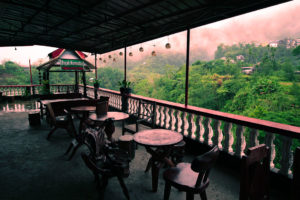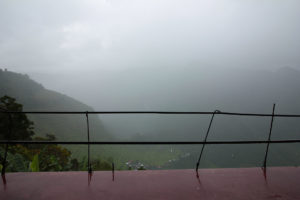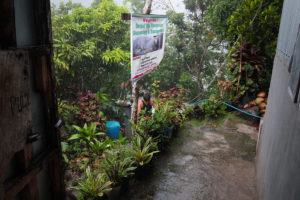
Rice and people
In so many countries in Southeast Asia, the bus is the number one means of transport. They are the ones connecting cities and villages.  Of course, there are also countries with many airports or a good train network. I think of Malaysia with its many runways or India with its huge rail system. But in many other countries the thousands of buses are the way to the next place. The Philippines is no exception, so I am sitting on a night bus from Manila to Banaue in the central highlands on Sunday night at 21:00. Both places are located on
Of course, there are also countries with many airports or a good train network. I think of Malaysia with its many runways or India with its huge rail system. But in many other countries the thousands of buses are the way to the next place. The Philippines is no exception, so I am sitting on a night bus from Manila to Banaue in the central highlands on Sunday night at 21:00. Both places are located on
Luzon, the largest of the approximately 7100 islands of the Philippines.
A whole lot of islands what? Only Indonesia still tops the former Spanish colony with some 10,000 more islands! Spanish? Yes exactly. There are only a handful of countries in Southeast Asia that have not been colonized. And the Philippines are not among them. Around 300 years the Spaniards have ruled here. They have introduced the Catholic faith, which is still practiced by more than 90% of the 100 million Filipinos.
In 1565 they claimed the Philippines as their colony and annexed it to New Spain. Islam, the religion which prevailed among Buddhism at that time, was not yet deeply rooted, and so it was not difficult for the Spaniards to – for the most part peacefully – convert the island empire to Christianity. By the way: the state was named by the “explorer” Ruy Lopez de Villalobos after the at that time Spanish successor to the throne, Philip II. Las Islas Filipinas.
The power of the Spaniards in the world faded and a new Philippine middle class was established, which could even afford, due to the international trade, to let their children study in Europe. But the Filipinos wanted equal rights and seats in the Spanish Cortes to be able to co-determine. Of all things, the Catholic Church in the Philippines initiated this movement. Later on it was about the independence from Spain, which did not have much to report anymore anyway and was in a war with America. The Americans destroyed the Spanish fleet in the bay of Manila and did not want to recognize the young Philippine Republic, which was just called out in 1898.
Instead, they led the next three years a merciless conquest in which one million Filipinos – then 20% of the total population – were killed.
After more and more concessions and rights for the locals, the Philippines was officially released in 1946 after the Japanese occupation in the second world war – which once again claimed a million dead.
The ride is bumpy and apparently there is also in the middle of the night very much traffic on Luzon’s streets. So the driver overtakes any of the trucks, which climb up the hills, abruptly hits the brake and then accelerates again. Over and over. At least he does not belong to the notorious honkers, I think to myself. But sleep isn’t really in on this trip. When the bus wiggles up the narrow mountain roads at 05:00 in the morning, I admire the beautiful mountain landscape in the province of Ifugao.
Finally, the bus reaches the destination shortly after 07:00. The mountain village of Banaue. Approximately 10,000 people live here, most of them belonging to the Ifugao, a very old mountain tribe. The province is also named after them. Since I can only check into my accommodation after 9 am, I make a short exploration to the village center on foot.
In the afternoon I would look at the rice terraces in Banaue, which are about 5km from the village center. But that does not happen, because after I have established myself in my room, the last night takes its toll and I sleep until 19:00 hahaha. The accommodation called “Rice Homestay” is cool and the staff, all one family, super friendly. They give themselves the greatest trouble to give me a feeling of home. For the morning, I have booked a driver who will take me to the rice terraces of Batad, which, unlike those of Banaue, are still on the list of UNESCO World Heritage Sites. UNESCO is very strict, I am told, and if too many changes are made to the surroundings, a place is removed from the list. This has happened with the terraces of Banaue. Here are some information about the rice terraces in the Ifugao province:
The terraces, which cover a large part of the province, are an example of the comprehensive design of a landscape by man.
Since supposedly 2000 years, on an altitude between 700 and 1500 meters, the mountains have been terraced with retaining walls and irrigated for the cultivation of rice and vegetables.
All surfaces, up to a slope of 70 degrees are used. The walls are the only precolonial stone buildings in the Philippines.
Construction and maintenance of the terraces are still subject to the traditional rules of the indigenous Ifugao. Above the fields are private forests (Muyong) to secure the water supply. No terrace is allowed to stop the flow of the water to the next lower level, the entire water volume is evenly distributed through dams, ditches and bamboo pipes in common ownership.
From an area of one square meter in a rice field, one can harvest about 1kg of rice
, Don Don, my driver for todays Tuesday, explaines to me. The work on the terraces is hard, he says, which is why there is no longer enough offspring, who is willing to do this not very lucrative work. Most farmers here are older than 40. Not even enough rice can be harvested for the whole year’s own needs, so even rice from other places has to be bought.
We reach the end of the curvy mountain road where Don Don will take a break and I can hike to the terraces. “Take your time,” he says. So the three hours we both reckon until my return. More on that later. After crossing a short stretch of highland forest, which reminds me a lot of the Cameron Highlands in Malaysia, I see the huge rice terraces. Wow, I’m amazed.
I walk down and get closer to the village core. At the bottom, I’m looking for a way up again, and I’m quite certain of stepping into a few gardens, that I should not. From afar, some Filipinos laugh at me, haha. But finally, I find my way and end back up where I started. In time. For five minutes after my arrival it is raining in streams.
Now a few completely wet Filipinos arrive at the lookout. They had bad luck, I think to myself. There is a little small talk and suddenly it turns out that they were the ones who laughed at me when I did not find the way down there, hahaha. They are superfriendly and interested. Kristine and her friend Maria with her husband Mike. A situation develops, that will be remembered:
A discussion about the identity of the Filipinos, with beer and gin – blended with green tea – before a captivating mountain scenery while the rain hits hard on the corrugated roof of the house.
The three like me, and when I actually break up at 5 pm, after some attempts, seven instead of three hours had already passed, since I left Don Don. In the meantime, the road has turned into a river and when I walk over it, my shoes and socks suck in water. The driver Don Don is still there and does not seem to be annoyed when he sees me. We drive back.
I have dinner. My favorite in the Philippines is Adobo. This is a meat dish, either with chicken or pork, with a vinegar and soy sauce. In the past, vinegar was also used as a natural preservative in order to make the meat last longer. So the dish has prevailed in the Philippines to this day. Then I watch a few episodes of the series “House of Cards” and go to sleep. Tomorrow would be a long day, as I would have to get from Banaue via Tarlac – to fetch Lim – to Mabalacat and this before 22:00 clock in the evening.
How this worked out, in the next post! Thank you for reading!





































